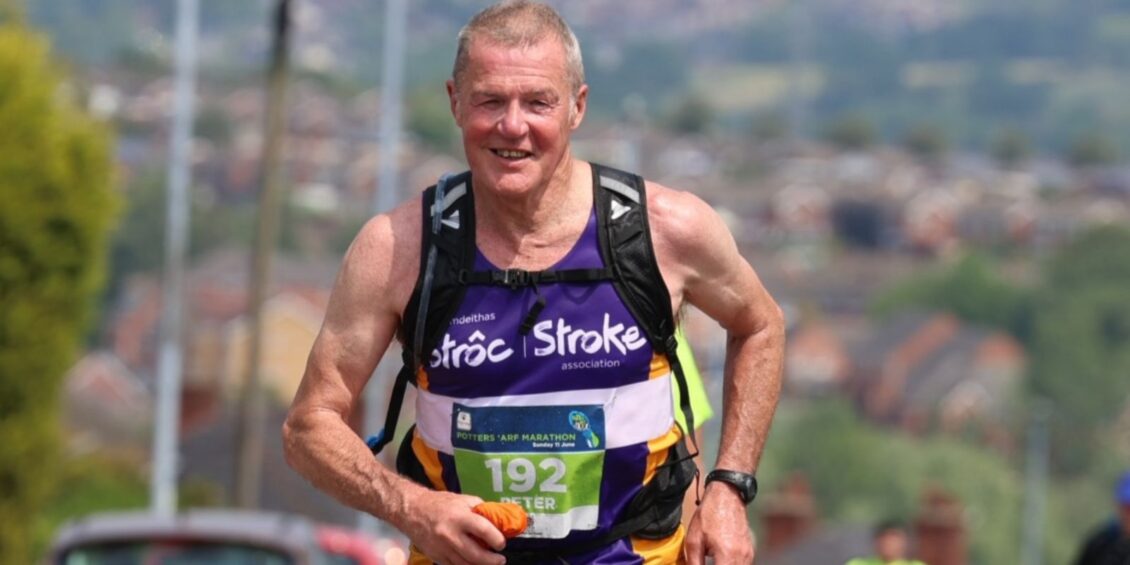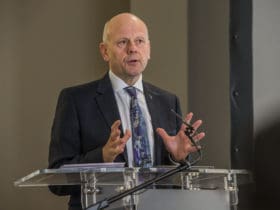Peter Hooper, who was saved by a “game changing” procedure after his stroke is backing calls for it to be made available across Wales.
The 64-year-old from Mold was treated with a procedure called thrombectomy, which involves inserting a small tool into the brain via an artery to pluck out the blood clot which is causing the stroke and killing brain cells.
Stroke Association Wales say the revolutionary procedure can save patients from severe disability or death. But currently it is only available to some patients at Cardiff Heath Hospital at limited times. It is the only hospital with a provision for thrombectomy in Wales. Many patients must hope they can be transferred to a hospital across the border, a delay which could have devastating consequences.
To mark World Thrombectomy Day, Wednesday 15 May and Stroke Awareness Month, the charity has called on the Welsh government to ensure a 24/7 thrombectomy service that is delivered equitably across Wales within the transformation of stroke services plans.
In June 2020, Peter was putting his family dogs out into the garden when he had the overwhelming sense of vertigo and fell.
“I tried to get up, but my left arm and leg just didn’t work. I tried calling for help but I couldn’t speak. My dogs knew something was wrong, so they started barking which woke my wife up. As soon as she saw me, she knew immediately it was a stroke.”
At the time of his stroke Peter lived in Cheshire,
“It was a minor miracle that the ambulance only took 30 minutes. The nearest hospital was Leighton Hospital near Crewe. Roughly the same distance away was the Royal Stoke Hospital in Stoke-on-Trent and my wife asked if I could be taken there. If I had gone to Leighton, I would have needed to be transferred to the Royal Stoke for more specialist care, potentially adding hours to my journey. So, I was blue-lighted to Stoke-on-Trent. What neither my wife or I knew at the time was that were only 24 hospitals in England which could offer the sort of stroke treatment I urgently needed; and worse, only 8 of those offered a 24/7 emergency service. It being early on a Sunday – Mid-Summer’s Day as it happens – I was incredibly lucky to be within half an hour of a world-class stroke centre and to be wheeled into an operating theatre just a few hours after my stroke.”
“I had a potentially catastrophic stroke; the impact was immediate and obvious. Without a thrombectomy, I was either going to die or face major and life-changing disability. The thrombectomy meant instead of weeks or months of intensive care and rehabilitation, and likely permanent disability, I walked unaided off the ward the day after my stroke. The following day I opened the door again and took the dogs out for their walk as normal.”
The former publisher did however struggle with the emotional impact of his stroke. “I’m not sure any stroke survivor gets off scot-free – I had a delayed reaction to the stroke about six months in and have needed support to manage issues like anxiety. Fatigue is a problem too, and I don’t quite have the physical stamina I used to. I still wild-swim year-round, I run on the local hills, cycle up and down the local hills and and so far since my stroke I’ve completed three half marathons, a very hilly 15km road race and the local Cilcain Mountain Race, all proudly sporting my Stroke Association running vest. Being able to drive still, I’m as independent now as I was pre-stroke.”
Peter attends local stroke groups in Buckley and Ewloe and sees the devastating impact stroke can have and how it is different for every stroke survivor
“The resilience and positivity of stroke survivors I meet in local stroke support groups always humbles me, and I’m a huge advocate of the Stroke Association’s Saving Brains campaign – I’m one of the lucky few to benefit from the miracle intervention that is thrombectomy: there are many more who would be eligible for the procedure but can’t get access to a specialist facility in the time frame required. In other European countries, if you need a thrombectomy, you get a thrombectomy, it’s a simple as that. Here in the UK, it’s a post-code lottery. I got lucky and it absolutely shouldn’t be a question of luck, not when the difference between treatment and non-treatment is so stark.”
Peter whilst living in rural Cheshire had good access to provision for thrombectomy, whereas if he was living in Mold just 35 miles from his previous address, he would have a separate NHS but due to pressures on the ambulance service, health board and wider NHS across Wales he may not have the same provision and outcomes. Where Peter lives now he would still have to travel to England to get a thrombectomy.
Katie Chappelle, Associate Director at the Stroke Association in Wales, said: “Thrombectomy is a very powerful treatment that instantly restores blood flow to the brain. It can treat severe strokes that would otherwise cause multiple disabilities or death.
“Yet despite the brilliant efforts of stroke doctors, nurses, paramedics and their teams to expand thrombectomy services to more patients, provision is still not available across Wales.”
“Between April 2023 and March 2024, 5050 people had a stroke in Wales. 116 of these received a thrombectomy. Just 16 of those were treated in Wales (at the University Hospital of Wales in Cardiff). Nearly 100 people travelled to England to have a thrombectomy; 78 in Bristol Royal Infirmary and 21 in The Walton Centre in Liverpool. There could be additional people who had a stroke in March which are yet to be processed due to a data lag, but these numbers will be small. The data highlights the lack of access to this life saving treatment in Wales.”
“As part of our Saving Brains campaign, we call on the Welsh Government to commit to ensuring that the work to transform stroke services is properly funded for the whole stroke pathway, including for thrombectomy expansion. Wales is behind other areas of the UK. We need to start developing the workforce now so that we can deliver this.”
“Given the wealth of evidence for the cost-effectiveness of thrombectomy, we believe that it is an investment worth making, even in these times of financial pressures.
“On average, each patient who receives thrombectomy saves the NHS £47,000 in on-going care over five years. Money that could be reinvested in health and social care services.”
Shakeel Ahmed, National Clinical Lead for Stroke in Wales said: “Mechanical thrombectomy is a life changing intervention that can significantly reduce disability from a stroke. Our thrombectomy rate has improved from 0.5% to 2.6% but we still have a long way to go to reach the 10% goal.
Our aim in Wales is to develop regional stroke services within a network as described in the quality statements that was published by the Welsh Government in September 2021 and adopt digital technology that will enhance the stroke pathway.
We have rolled Brainomix AI platform across all sites in Wales which will support the digital connection of the networks that facilitates fast clinical decision-making, allowing stroke patients to be diagnosed and treated with speed and thereby improving clinical outcomes.
We anticipate the AI platform will enhance and smooth out some of the pinch points in the thrombectomy & thrombolysis pathway which in turn lead to an increase in the number of patients being treated.”








Leave a Reply
View Comments